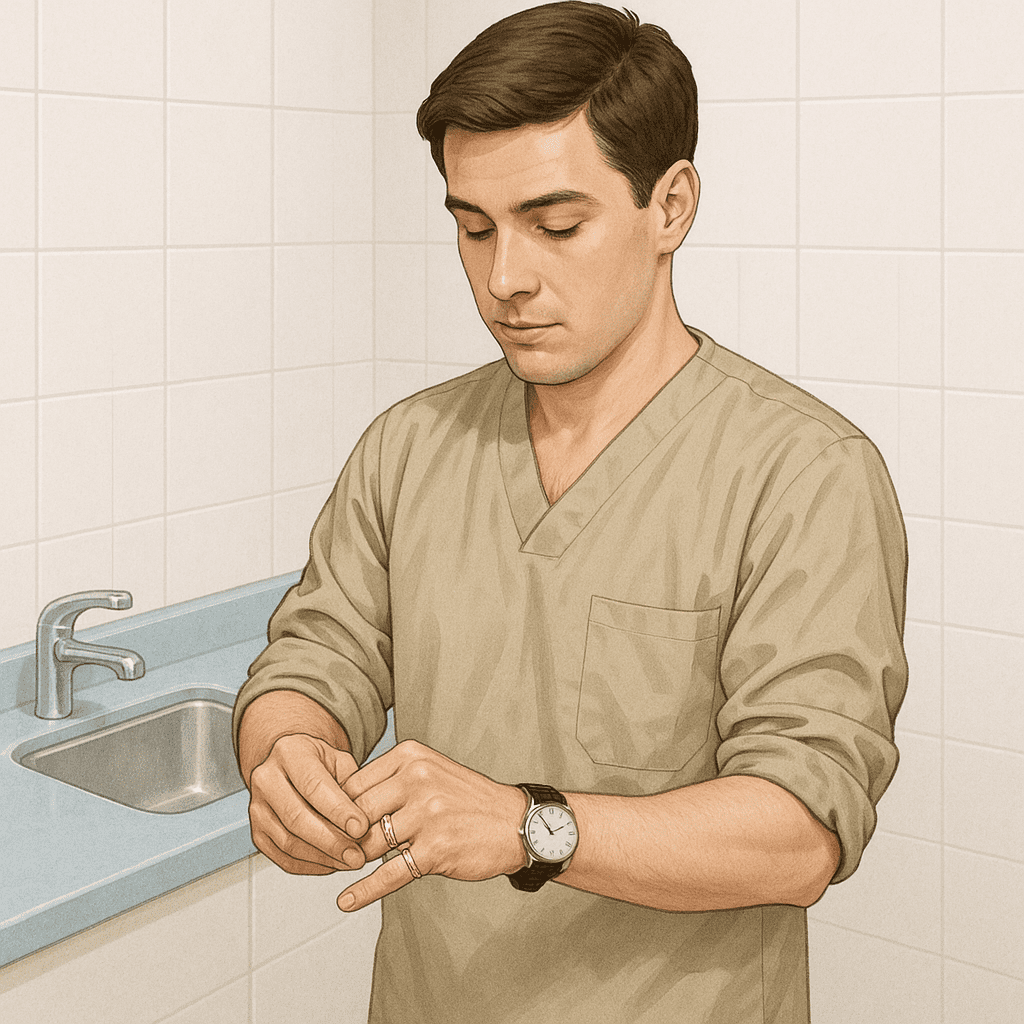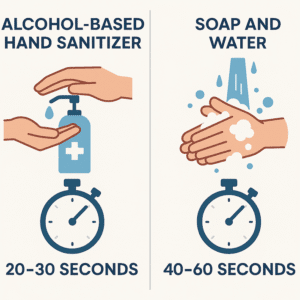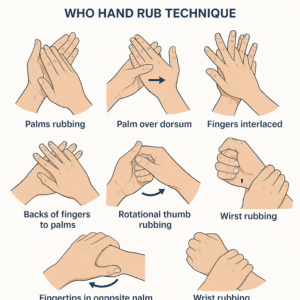Hand Rub Technique: Step-by-Step Guide for OSCE Success
Hand Rub Technique: Step-by-Step Guide for OSCE Success (2025 Update)
Introduction to Hand Rub in Clinical Practice
Hand hygiene is one of the most vital infection control measures in healthcare. For medical students and nursing candidates preparing for OSCE (Objective Structured Clinical Examination), mastering the hand rub technique step-by-step is not just a clinical necessity but also a scoring criterion.
This guide breaks down the WHO-recommended hand hygiene steps, highlights OSCE-specific exam tips, and provides a practical checklist to help you ace your exam confidently.
Why Hand Rub Technique Matters in OSCE Exams
Infection Control and Patient Safety
Proper hand hygiene prevents the spread of healthcare-associated infections (HAIs). In OSCEs, failing to demonstrate this skill correctly can represent a risk to patient safety, which examiners take very seriously.
Examiner’s Marking Scheme and Expectations
In OSCE stations, examiners expect you to:
Verbalize when you are performing hand hygiene.
Demonstrate correct technique.
Time yourself for at least 20–30 seconds with sanitizer.
Avoid missed steps that may result in mark deductions.
Preparation Before Hand Hygiene
Removing Jewelry and Watches

Before beginning, remove rings, watches, and bracelets, as they harbor bacteria and compromise technique.
Adjusting Sleeves Above the Wrists
Ensure sleeves are rolled up above the wrists to expose the full hand and wrist area for cleaning.
Choosing Between Soap-and-Water vs Hand Rub
Alcohol-based hand rub (ABHR) is the gold standard unless hands are visibly dirty.
If soiled with blood, fluids, or dirt → use soap and water (40–60 seconds).
Otherwise → use hand rub (20–30 seconds).
Hand Rub Technique: Step-by-Step Sequence
To perform effective hand hygiene, follow the WHO 7 steps of hand rub:
1. Palm to Palm Rubbing
Place a palmful of sanitizer into your cupped hand and rub palms together to distribute evenly.
2. Palm Over Dorsum with Fingers Interlaced
Place your right palm over the back of your left hand, interlace fingers, and rub. Repeat with the opposite hand.
3. Palm to Palm with Fingers Interlaced
Interlace fingers palm-to-palm and rub thoroughly.
4. Backs of Fingers to Opposing Palms
Interlock fingers with palms facing inward, rubbing the backs of fingers against the opposite palm.
5. Rotational Rubbing of Thumbs
Enclose your thumb with the opposite palm and rotate. Repeat with the other thumb.
6. Rotational Rubbing of Fingertips in Palm
Place fingertips into the opposite palm and rub in circular motions to clean under nails.
7. Rubbing the Wrists
Encircle each wrist with the opposite hand and rub rotationally.
8. Allowing Hands to Air Dry
Let hands air dry completely before touching any surfaces. Do not wipe with tissues or clothing.
Key OSCE Tips for Hand Hygiene
WHO’s 5 Moments of Hand Hygiene

Always demonstrate awareness of the 5 critical moments:
Before touching a patient.
Before clean/aseptic procedures.
After exposure to body fluids.
After touching a patient.
After touching patient surroundings.
Timing: 20–30 Seconds for Sanitizer
Use 20–30 seconds for alcohol-based rub and 40–60 seconds for soap and water.
Common Mistakes That Lose Marks
Skipping thumb or wrist rub.
Touching surfaces before drying.
Forgetting to verbalize hand hygiene.
Hand Rub vs Soap and Water: When to Use Each

Visibly Soiled Hands
Always choose soap and water if blood, dirt, or other contaminants are visible.
Routine OSCE Scenarios
For standard OSCE scenarios, alcohol-based sanitizer is preferred unless specified otherwise.
Fast OSCE Recall
Here’s a quick mental shortcut for the sequence:
Palm to palm → Palm over dorsum → Fingers interlaced → Backs of fingers → Thumbs → Fingertips in palm → Wrists → Air dry.
High-Yield Visual Resources for OSCE Preparation
Students should review:
WHO Hand Hygiene Posters
NMC OSCE Hand Hygiene Guides
Visual flashcards and mnemonics for last-minute exam prep.
(Reference: World Health Organisation – Hand Hygiene)
Frequently Asked Questions (FAQs)
Why is hand rub crucial in OSCE?
It prevents infection transmission and is a core marking criterion in clinical exams.
Can rings or watches be worn?
No. Jewelry and watches must be removed before hand hygiene.
Is soap and water preferred over sanitizer?
Use sanitizer unless hands are visibly soiled—then use soap and water.
How long should hand hygiene take?
20–30 seconds with sanitizer.
40–60 seconds with soap and water.
What if a step is missed during OSCE?
You should repeat the entire hand rub sequence—examiners penalize missed steps.
How do examiners score hand hygiene?
They assess preparation, sequence, timing, and awareness of WHO 5 moments.
Conclusion: Mastering Hand Hygiene for OSCE Success
The hand rub technique step-by-step is a must-know skill for every OSCE candidate. Correct execution not only earns full marks but also reflects your commitment to patient safety and professionalism.
Remember to:
✔ Remove jewelry and roll up sleeves.
✔ Use sanitizer for 20–30 seconds (soap if visibly soiled).
✔ Follow the correct WHO sequence.
✔ Verbalize your hand hygiene in exams.
✔ Let hands air dry before touching surfaces.
By mastering this, you’ll walk into your OSCE with confidence and precision, ensuring you score maximum marks while practicing safe patient care.






